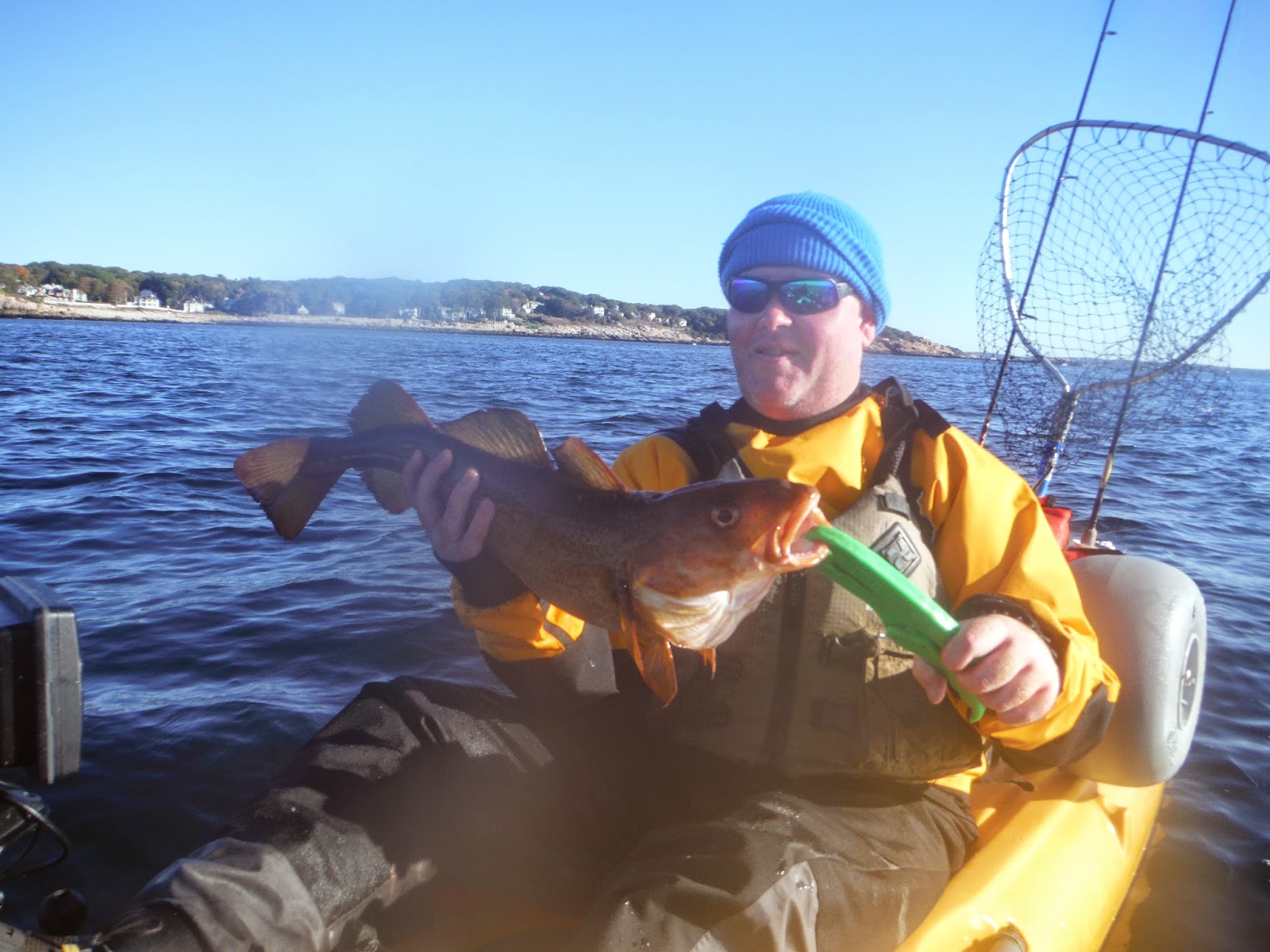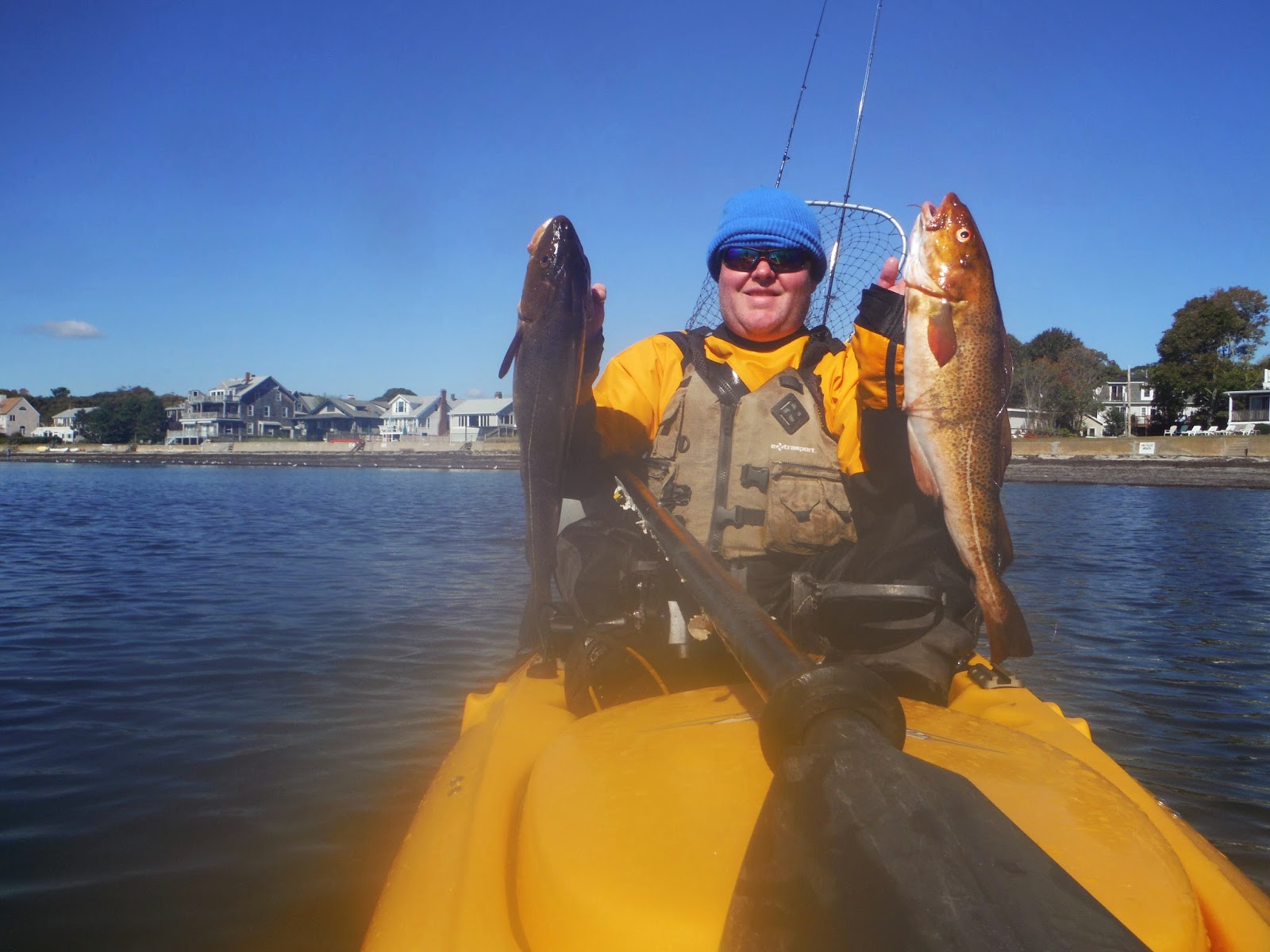I travelled to the Massachusetts coast on Columbus Day weekend for a short trip. Each morning, I fished for about the first three hours after dawn targeting cod, which is something that has been on my bucket list for a long time. I've never caught a cod before and to catch one from a kayak was special. I was lucky enough to have two friends in the area that were inshore cod sharpies. The first day, Eric Hromada showed me the ropes in terms of targeting cod and looking for appropriate structure to find them. In terms of structure, we were fishing sunken islands in 50' - 80' and reading our sonar for boulders and scattered rocks along the bottom where the cod were congregated. The cod were moving from area to area quickly for a bottom fish (sort of like black sea bass), so locating a few good humps with some rocks allowed us to move with the cod. It was a great morning and my largest cod was 28". The second day, Eric Harrison showed me a different area with similar results with my largest cod being about 26". We were fishing with a larger group including Mike Baker and Mike Bartgis, who travelled all the way up from Maryland, and James Fisher and everyone caught some cod. Baker, who made the trip down from Maine, caught the largest cod of the day at 31". The final morning I went solo and worked some GPS waypoints. Although it was a little slower since 1/3 hours included fishing during the slack tide, I still caught several cod with my largest being about 27". There was an onshore wind the final day and the new revo handled the choppier weather well. Over three mornings, I caught over 30 cod. I caught all my cod on non-baited jigging spoons with 2 ounce gold hammered diamond jigs and hogy sand eels producing best. Cod are definitely underrated fighters, and the toughest part was pulling them off the bottom. After hooking up, they dig into the bottom and make a strong run that doubled over my medium spinning rod to the point it looked like it would break! I was vertically jigging these cod and they almost always took the jig on the rise, which is unusual because almost every other species I target grabs it on the drop. The water temp was 55 degrees but the air temp was in the low 40s, so it was much cooler than down here on Long Island where I'm still wearing swim trunks in mid-60s water temps. Oh, and the cod hate slack water. It was great seeing everyone, as I hadn't seen a couple of those guys since the spring. Thanks again so much to Eric Hromada and Eric Harrison for taking some time out and showing me around. It was greatly appreciated. I couldn't ask for better hosts or better company. Here are some pics:
Long Island Kayak Angler
Wednesday, January 7, 2015
Kayak Fishing Tautog Opening Weekend 2014
It was very rainy day to open the tog season and I was soaked even with good rain protection and a dry top. It was a solid bite on shallow water tog, and I caught about 15 tog with my largest being 22.5", 22.5", and 21". Here are some pictures. I started on the Sound but it was too rough so I moved inshore. It was cold out there with constant rain and felt more like November.
Thursday, October 23, 2014
September Albies - Stonington Invitational - Watch Hill, RI
Each September I take off some time to fish saltwater from the kayak. September can be the best month of the year for weakfish and if the albies show, the month can produce some of the best variety of quality fish for the year.
The albies hadn't shown in force in this area since 2012. Last year, the inshore run of pelagics was short and only in a few isolated areas. This year, the albies showed up with a vengence and the fishing was very good for my two trips to Watch Hill, RI.
My two trips to Watch Hill were on September 17 and three days later on September 20 for the Stonington Invitational.
On my birthday, I took the day off and targeted false albacore from the kayak in western Rhode Island with Tom Comito. After a 4 am wakeup on LI, I opened the dawn on the water on the Block Island Sound to a nice September sunrise over the Watch Hill lighthouse. The albies were already busting out of the water by the time we got there and we both caught. There wasn't much wind, and the albies weren't up for too long, and I caught all my fish blindcasting and also one trolling. Today, flies were the order of the day and sand eel patterns produced. It was the first time that I caught an albie trolling and I wasn't disappointed - it gave me an unbelievable fight even on a stiff medium mini surf rod with a 5000 class reel.
A few days later, I went back to fish the Stonington Invitational with Rick Hacker. This was sponsored by Stonington Marina. This time, we encountered two different species. In addition to false albacore, Rick jigged up a couple of bonito as well. These were Ricks first pelagics and I believe he is addicted as well. It was a tough bite and the albies weren't crashing bait on the surface so they were tough to find and we had to blind cast to catch them. I hooked into 4 albies and landed 3. I also caught my personal best alibie, which measured 27". Three hookups on flies, one on plastic. I caught this fish on a medium spinning rod and the battle may have been the best I ever had. These fish are no joke and are the most tireless fighters in open water that I have encountered. The fight is constant, and sometimes they turn on a dime and come back towards the kayak, which makes you feel like you have lost them. The weather turned bad so I only stayed for the day. In fact, the surf was far worse than Magic Seaweed had predicted. Instead of 1' swells, it was a constant 4' swell by mid-morning, with standing waves up to 6' on the big rip. It was a white knuckler getting through the rip near low tide, but there was only shore break on the beach. Seas were predicted to be worse today so I cancelled my reservation and drove home in the mid-afternoon.
Wednesday, October 1, 2014
Long Island Fisherman Magazine - Article - Harbor Hopping on the Western Sound
The Fisherman Magazine published an article that I wrote this month entitled Harbor Hopping on the Western Sound. The article discusses kayak fishing the fall striper fishery in the harbors and bays of the western Long Island Sound on the north shore of Long Island. I've been fishing this pattern for about 7 seasons and it is very reliable. The consistency of the pattern is especially important as a backup plan to summer-run weakfish, whose presence can vary from season to season. It is also a good contingency plan if pelagics like false albacore / bonito don't show, which is another local fishery that sometimes lacks consistency. Also, if you can't make it to the east end to fish the fall run at Montauk, this can be a good alternative. This fishery is quantity over quality. Although you won't catch many trophies, 20 - 40 stripers per trip is the norm. Most of these fish will be from 20" - 27". This issue also contains another article about kayak fishing featuring some familiar faces such as Eric Harrison, Elias Vaisberg, Shawn UncleDuke Barham, and CaptJerry Collins. The Fisherman Magazine is focusing on the growing trend of kayak fishing and this is my third article this year and fifth in last three years. Magazines are starting to recognize the substantial number of anglers that are abandoning boat and surf to fish from kayaks. I greatly appreciate the opportunity and recommend checking the magazine out. Here are some pictures.
Summer Bottom Fishing - Long Island Sound - Scup and Black Sea Bass
For most of August, I dedicated one evening after work to targeting scup on some rockpiles near points on the western Long Island Sound. Usually, I would fish from about 7 pm until dark. Tactically, I was diamond jigging with 1 ounce jigs tipped with sandworm or Gulp. The scup liked a horizontal retrieve and held in tight schools over certain structure, so a GPS was useful for working schools and eliminating dead areas. Vertical jigging wasn't as productive, but also worked on nights where the scup were aggressive. Over three weeks, I caught several scup in the 18" range.
I also jigged up some keeper sea bass as well to about 17", which was a really nice bonus. This is the first time I saw nice sea bass so far inshore and I hope it was the start of a trend.
September Night Stripers on the Long Island Sound - 9-2-14

Tuesday, August 26, 2014
Kayak Fishing for Kokanee Salmon - August 24, 2014
Kokanee are landlocked sockeye salmon. They don't grow as big as their sea run counterparts and are similar in size to brook trout. One of my goals for the fishing season was to catch a kokanee that qualifies for a CT trophy award. In CT, the kokanee must be at least 17" to qualify for a catch and release award.
The kokanee fishing is challenging. Firstly, it is a niche fishery which requires specialized equipment. For the kayak angler, leadcore with dodgers or flashers is a must. Shoe peg corn is also necessary.
After hooking into one, the loss rate is high because the kokes have very soft mouths and I've seen the hook clear straight through the mouth, so a gentle rod tip is valuable as well.
Further, you must troll very slow at about 1 mph for the kokes to hit.
With all the nuances, you must specifically target kokes and they are rarely caught as bycatch.
I had a productive morning and caught 3 kokanee. Each salmon was 14". I used a wedding ring spinner behind a flasher.
I like East Twin a little more than West Hill because it is much bigger, which leads to longer trolls and the ability to cover a larger territory. However, I travelled a long way before I could find the kokes. They were in 30' and some as deep as 40'. I marked trout higher in the thermocline at 20'.
The kokanee I caught were similar in size to last year and didn't appear to be turning yet. Kokes have a three year life cycle and all of the fish I caught were third year salmon that will begin to turn red in about a month.
I will be returning on September 9 for one more shot at a big fish before the fish begin to turn and stop feeding.

Subscribe to:
Comments (Atom)










































